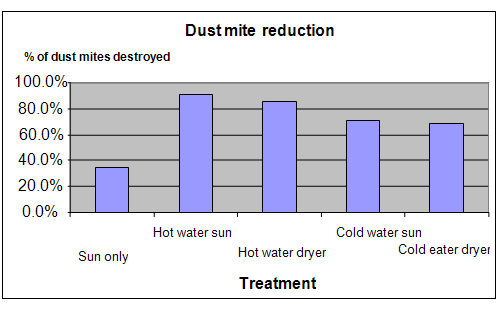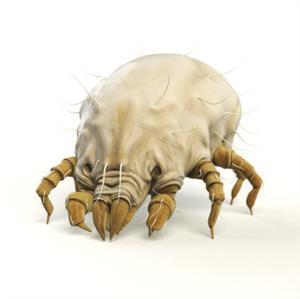| Complexity level: | 5 |
| Project cost ($): | 5 |
| Time required: | 2 hours to prepare, 2 days for the science project experiment |
| Material availability: | Easily found |
| Safety concerns: | None |
Hypothesis
Washing pillow cases in hot water and drying them in the hot sun, is the best method to eradicate dust mites.
Overview
Dust mites
Dust mites are tiny microscopic bugs that live by consuming dead skin cells that are regularly shed by human beings. Dust mites do not carry any diseases and are quite harmless to humans. However, they do trigger asthma attacks and allergic reactions in those who are allergic to dust mite feces.
A typical dust mite is only about 0.4mm long. They have 8 legs and are a creamy blue color. A male dust mite can live up to 19 days while a female dust mite lives up to 70 day and can lay up to 100 eggs. A dust mite can survive in any climate but they thrive best in our homes! Dust mites are normally found in pillows, mattresses, carpets and furniture.
Most of a dust mites’ waste can be removed by washing. Dust mites can be killed by exposing them to temperatures above 55 °C or at temperatures below 0 °C. A relative humidity falling below 50% can also be fatal to dust mites.
Scientific Terms
Materials
The materials required for this science fair project:
- 5 dust mite infected pillow cases
- 1 washing machine
- 1 laundry dryer
- tap water
- 1 magnifying glass
- 1 black marker pen
- 1 ruler
Procedure
1. For this science fair project, the independent variable is the method of removing the dust mites – sun drying, hot wash followed by sun drying, hot wash followed by dryer cycles, cold wash followed by sun drying or cold wash followed by dryer cycles. The dependent variable is the number of dust mites remaining on the pillow case. This is determined by observing the pillow case under the magnifying glass and counting the number of dust mites. The constants (control variables) are the size of the marked area, the type of pillow case cloth, the hot water temperatures and the cold water temperatures.
2. Five pillow cases which are known to be infected with dust mites are chosen for this science fair project. The material for all 5 pillow case must be the same.
3. Using the ruler and marker pen, a 5cm by 5cm area is marked on the pillow case. By observing with a magnifying glass, the number of dust mites found in the area is counted for each of the 5 pillow cases and recorded in the table given below.
4. The 5 pillow case are then subjected to the following conditions:
a. Pillow case 1 – hang and dry under a hot afternoon sun for 2 hours
b. Pillow case 2 - wash in hot water at 60 °C and dry in the hot sun for 2 hours
c. Pillow case 3 - wash in hot water at 60 °C and dry in a dryer for 2 hours
d. Pillow case 4 - wash in cold water at 0 °C and dry in the hot sun for 2 hours
e. Pillow case 5 - wash in cold water at 0 °C and dry in a dryer for 2 hours
5. The 4 pillow cases that are to be washed are placed in the washing machine separately to prevent cross contamination. After drying, the pillow cases are inspected under the magnifying glass once again and the number of dust mites are counted and recorded in the table below.

Results
The pillow case that was washed in hot water and dried under the hot sun had the least number of dust mites. The pillow case that was dried in the sun without first being washed had the highest number of remaining dust mites.
|
Condition |
Number of dust mites before and after washing and/or drying condition |
||||
|
Sun only |
Hot water sun |
Hot water dryer |
Cold water sun |
Cold eater dryer |
|
|
Before |
35 |
42 |
48 |
37 |
41 |
|
After |
23 |
4 |
7 |
11 |
13 |
|
% reduction |
34.3% |
90.5% |
85.4% |
70.3% |
68.3% |
The chart below represents the results of our science project

Conclusion
The hypothesis has been proven to be true - washing pillow cases in hot water and drying them in the hot sun is the best method to eradicate dust mites.
The feces produced by dust mites contain allergenic enzymes. They are one of the most common triggers of asthma. Among the other common allergic symptoms are sneezing, running nose, watery eyes and itchiness.
Also consider
This science project experiment can also be repeated at different hot water temperatures, to compare the number of surviving dust mites.
Try to repeat the science experiment using different types of materials like carpet, nylon or cotton and compare your findings.
References
House dust mite - http://en.wikipedia.org/wiki/House_dust_mite
Dust mites - http://healthandenergy.com/dust_mites.htm
Dust mites - everything you might not want to know! - http://www.ehso.com/ehshome/dustmites.php

